
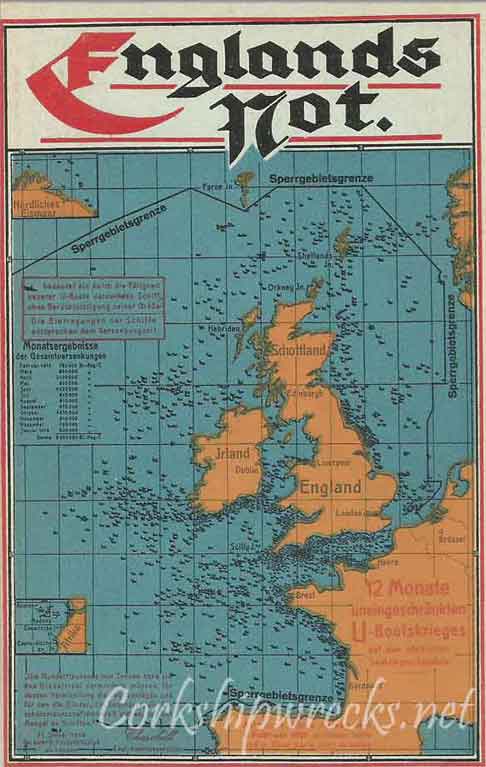
German propaganda postcard showing the level of sinkings by u-boat in 1917
The entry of the United States into the First World War in 1917 saw the arrival of US forces in Europe to aid the Allied cause. The US Navy had bases in mainland Europe and the British Isles in an attempt to combat the U-Boat menace, including the first at Queenstown (Cobh) in Ireland.
The Naval Aviation Branch, known as the United States Naval Air Service also needed bases for the recently developed weapon of the flying boat, as well as stations for kite balloons.
In Ireland there were four flying boat bases, located at: Queenstown (actually Aghada in Cork) Wexford, Lough Foyle, and Whiddy Island. There was also a kite balloon station at Berehaven in West Cork.
This Irish unit was organised as USNAS Ireland under Commander F.McCrary, who was based at Queenstown.
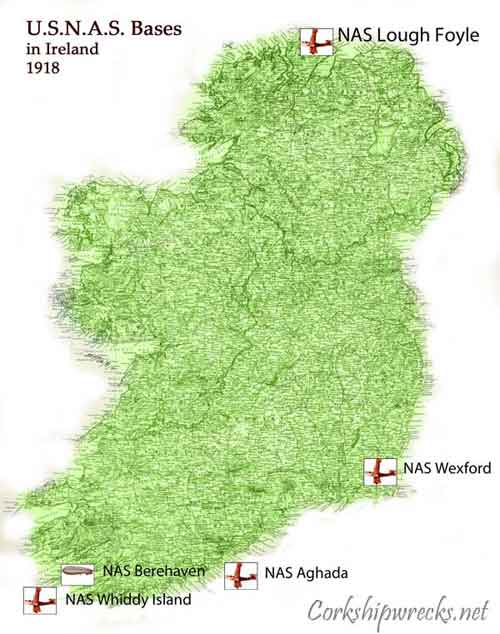
USNAS Bases in Ireland, 1918.
The command was established in February 1918 and all bases were completed by September 1918. The largest base, and headquarters for Ireland, was in Aghada (Queenstown), on the eastern side of Cork Harbour, on a site chosen by the British Admiralty .
This land was commandeered under the ‘Defence of the Realm’ act. Aghada was not only an operational flying boat base, but also was the assembly premises for planes, and training station for pilots on the 'Ireland Station'.
The Aghada station had an area of operations that covered areas from Cape Clear in the West, to the convoy channels to the east on the routes to France in the St Georges Channel.
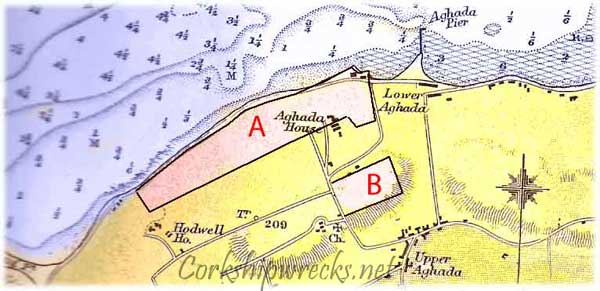
A. Site of airbase at waters edge. This included 6 hangers, concrete apron, slipway, pier,maintenance sheds, assembly sheds, wireless installation, pigeon loft, storage sheds. Saobhran Cottage on shore also taken over. New road built inland to enlarge site. Lower Aghada British Army camp, taken over and used for administration. Aghada Hall and new hutments used as Headquaters for USNAS Ireland.
B. ‘Timber Town’, (Upper Aghada British Army camp). Taken over by USNAS. Used for living quarters for enlisted men and ancillary works. Also included YMCA building.
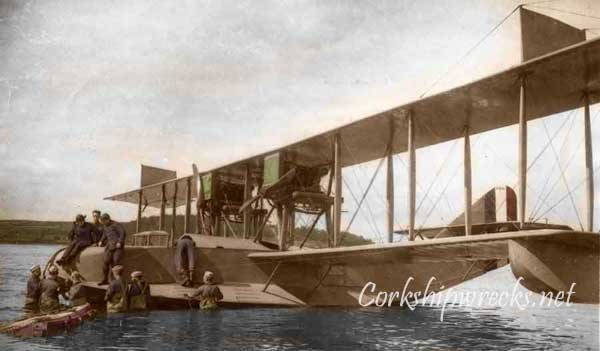
Curtiss H16 after first flight, Aghada.
The flying boats used in Ireland were of one type, the Curtiss Large America H16. This aircraft, which was enormous for it’s time was a twin-engined craft with a 76ft wingspan and 2 x 400hp liberty engines. It’s length was 46 feet.
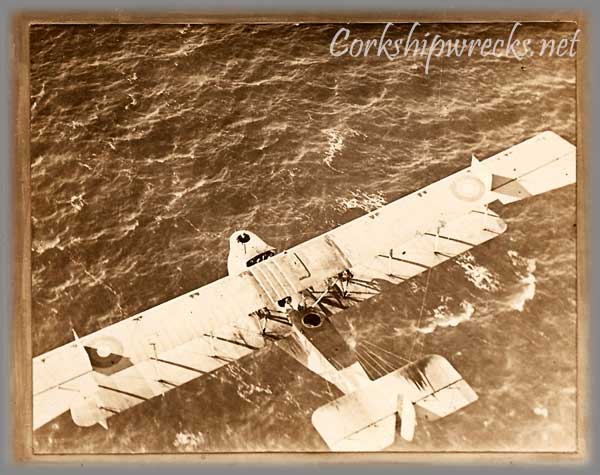
Curtiss H16 Large America a view from above
The first planes arrived in Queenstown in June 1918 and operational patrols began in August 1918. The Aghada base had 28 planes and nearly 1500 personnel by the Armistice in November 1918.
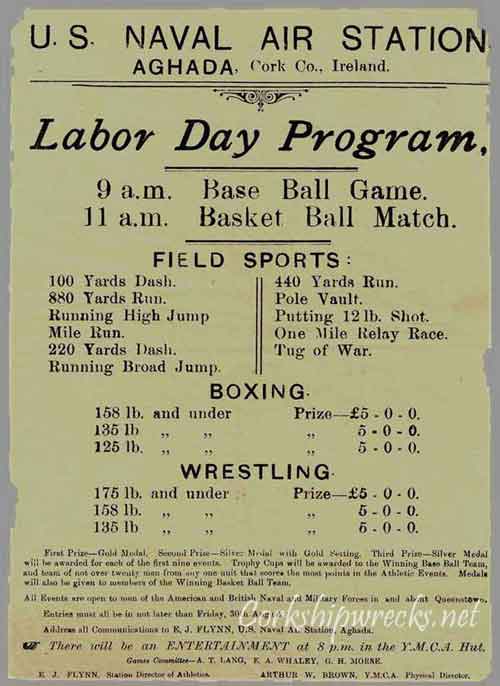
These were the early stages of naval aviation, and the fact the USNAS managed to have patrols in operation was very creditable. The lack of success in destroying German submarines was tempered with the fact that the German High Command became very wary of theses patrols, and tried to route their flotillas round them, hampering operations.
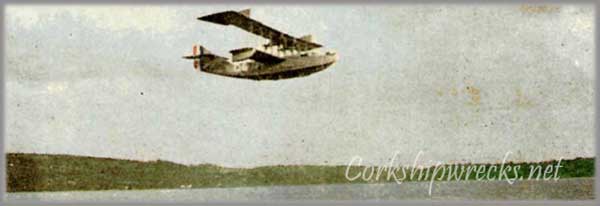
Curtiss H16 airborne over Cork Harbour (East Ferry in background)
The only known fatality from operations on the Irish Coast was the crash of aircraft no A1072 in Whiddy, on the 22nd October 1918 resulting in the loss of one crew member. With the Armistice there was no need for these bases and the Queenstown base closed on the 10th of April 1919.
Quickly the fixtures and fittings were sold and auctioned off to the residents and businesses of Cork, and notices such as the ones below continued in the local press for most of the summer of 1919.
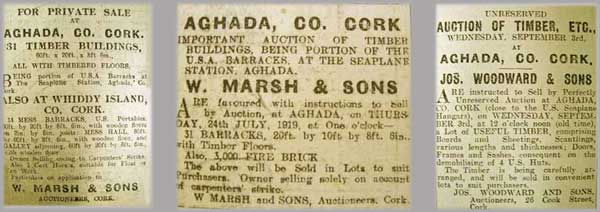
In 1919 two Royal Irish Constabulary (RIC) officers, were apprehended by the US naval guard breaking into the stores at the Aghada base. both were jailed.
By the mid-1920's, all the buildings on the base were gone, what remained was;
A solid concrete foundation for the six hangers and apron, measuring a gigantic 112,860 feet.
Two concrete floors just to the west of this, measuring 80 x 70 feet.
A quarry adjacent to the site capable of providing most building materials
The large concrete slipway, capable of launching vessels up to fifty feet in length
A stone pier to the west, which could be extended by replacing the pilings to 250 feet.
Six concrete shed foundations, near the pier, measuring 100 x 25 feet.
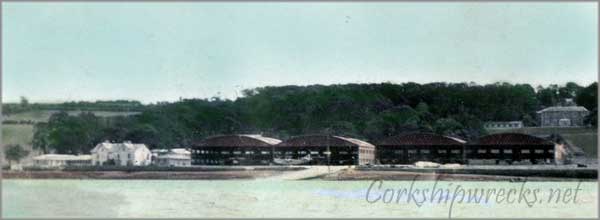
Aghada from the water, 1918
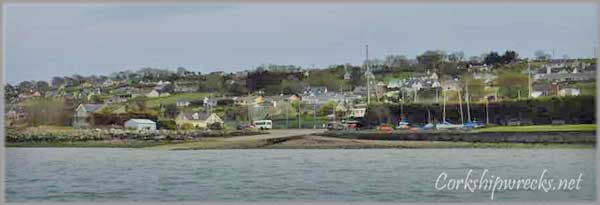
Aghada today, Aghada Hall was burned to the ground during the Irish Civil War
There was also a substantial concrete roadway joining all these remains, as well as a seawall to protect the site. It was envisaged that industry would be attracted to the site, but this was not to happen for some years. The only development seen was for the local Improvement Committee, to get tennis courts built on some of the gigantic concrete slabs - the club survives to this day.
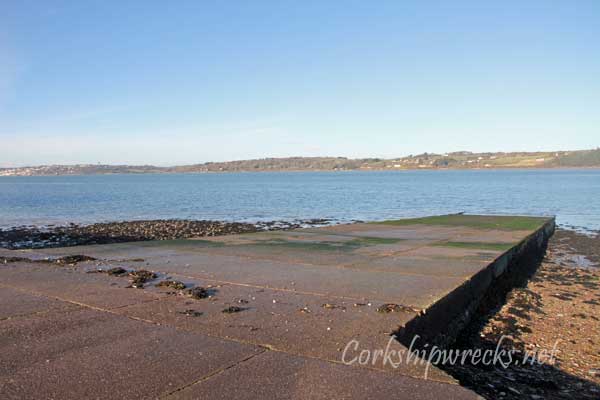
The Aghada slipway today, constructed for flying boats, now used by leisure craft
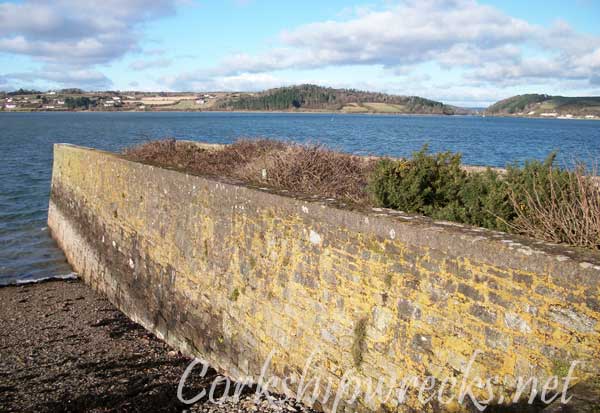
The remains of the pier used to access the harbour, known locally as the 'Yankee Pier'
In 1919 there was an ambitious plan, on behalf of The Great Northern Aerial Syndicate , to use Aghada as a base for giant airships crossing the Atlantic, each carrying 150 passengers. In the late 1920's and early 1930's, the site was examined as a potential seaplane base, by companies, such as Royal Dutch Airlines , who sent a representative to visit and take photos, but to no avail.
In the 1960's there was a short-lived attempt to produce hovercraft in a building on the western edge of the site, but this quickly failed
USNAS Operations in Ireland, to Nov 11th 1918.
Queenstown
Operations commenced: Sep 30th 1918
Aircraft Nov 11th 1918: 28 Seaplanes
Number of flights 64
Number of sea miles patrolled 11,568
Number of officers 72
Numbers of men 1426
Lough Foyle:
Operations commenced: Sep 3rd 1918
Aircraft Nov 11th 1918: 7 Seaplanes
Number of flights 6000
Number of sea miles patrolled 11,568
Number of officers 20
Numbers of men 432
Wexford:
Operations commenced: Sep 18th 1918
Aircraft Nov 11th 1918: 5 Seaplanes
Number of flights 98
Number of sea miles patrolled 19,135
Number of officers 22
Numbers of men 405
Whiddy Island:
Operations commenced: Sep 25th 1918
Aircraft Nov 11th 1918: 3 Seaplanes
Number of flights 25
Number of sea miles patrolled 3870
Number of officers 18
Numbers of men 400
Berehaven
Operations commenced: May 21st 1918
SOURCES
There have been a number of publications detailing the history of Queenstown (Cobh) during World War One. The standard reference works are those those listed below
Danger Zone. The story of the Queenstown Command.
By E.Keeble Chatterton
Little, Brown and Co, Boston 1934
(copy available in Cork City Library – local history section top floor)
The Victory at Sea. By Rear-Admiral William Sowden Sims, Doubleday, Page and Company, New York, 1921.
Simsadus London, The American Navy in Europe.
By John Langdon Leighton.
Henry Holt & Co, New York, 1921.
Available to download here
Annual Report of the Secretary of the Navy
For the Fiscal Year, 1918
Available to download here
Officers and Enlisted Men of the US Navy who died during WW1
Available to download here
Bayley’s Navy,
by Vice Admiral Walter.S.Delany (Rtd)
Available to download here
American Participation in the Great War,
by Captain Dudley W.Knox.
Available to download here
Naval Aviation in WW1,
by Adrian O. Van Wyen.
Available to download here
For Operational Records Various files from the Public Records Office,of the United Kingdom, Kew are invaluable, especially records of ADM137, which were files bound for the official history of WW1 Naval Operations. None of these records are digitised yet, and can only be accessed by visiting the British Public Records Office, Kew, near London.
www.nationalarchives.gov.uk/
For photographs of the Queenstown Command, the following websites have many photographs available to download free of charge. Most of the aforementioned publications also have photographic illustrations.
US Naval History and Heritage Command website
www.history.navy.mil
United States National Archives Website
www.archives.gov/
The British Imperial War Museum
www.iwm.org.uk/research
This site contains many photographs of US and British Naval operations in Ireland. Importantly, it also has a number of copies of unique newsreel footage. These can be played on the site.
